Last Updated: May 21, 2025
So your favorite weather app is telling you that it’s raining every day in Costa Rica. Of course you’re stressed! Before you start canceling plans or stocking up on ponchos, keep reading. We’ve lived in Costa Rica for over a decade and have learned that the forecast isn’t reliable. In this post, we’ll explain how the weather in Costa Rica is predicted, discuss the different seasons, and let you know (as best we can) what to expect for your trip.
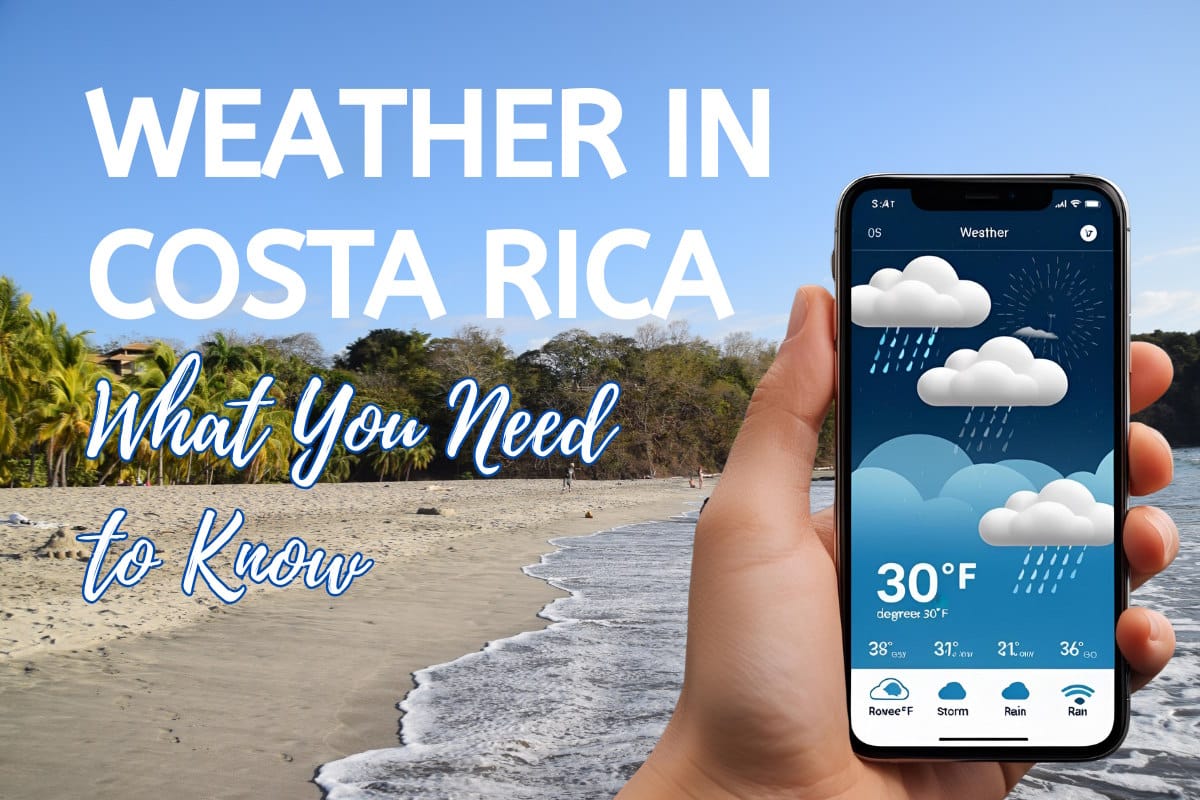
Key Takeaways
- Don’t stress about your weather app—it doesn’t work for Costa Rica.
- The months of December to April are the driest for most of the country, except the Caribbean coast.
- Rainy season (May to November) can still be great. It will rain but not all day, every day. More likely, you’ll have dry and sunny mornings then a storm or shower in the afternoon.
- The wettest months are September and October but that is also the driest time of year on the Caribbean coast.
- Costa Rica’s high temperatures range from 85-95°F (29-35°C) at the beach and 70s°F (21-26°C) in the mountains.
- Humidity ranges from 60-90%, depending on location and season. Yes, it’s humid!
Is the Costa Rica Weather Forecast Reliable?
The short answer is no.
Forecasting the weather in Costa Rica is a complicated job. This tiny country is nestled between two churning oceans and has several steep mountain ranges, creating many different microclimates. These factors make forecasting for any one specific area difficult.
There is also very limited weather infrastructure in Costa Rica. Unlike other countries where radar towers pick up every drop of precipitation, meteorologists here mostly analyze satellite images of cloud cover instead.
The problem is that those clouds change quickly, especially over oceans and mountains, so forecasting more than a day in advance isn’t easy. This is one reason why your weather app shows a chance of rain for several days in a row (it’s just guessing!)
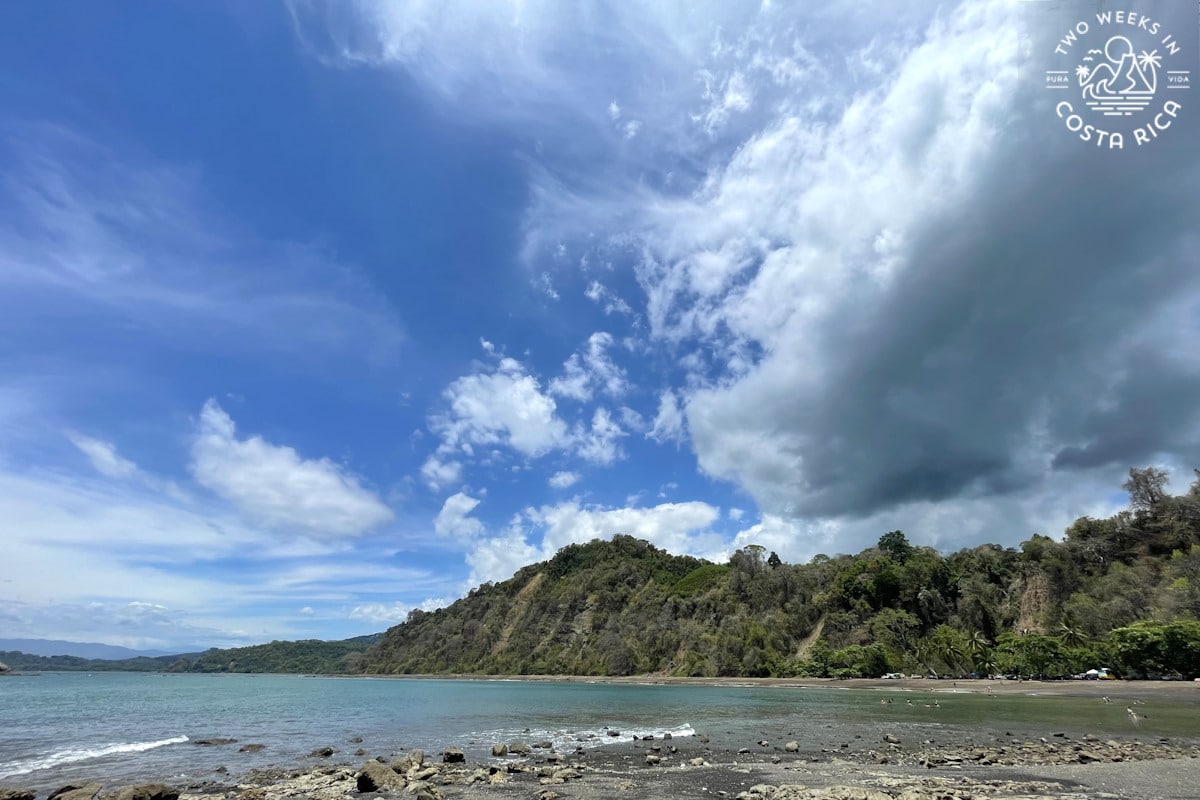
Costa Rica’s Seasons
Costa Rica has two seasons: the dry season and the rainy or “green” season.
Dry Season
Dry season generally goes from December through April. During the dry season, much of the country experiences little, if any, rainfall.
Rainy Season
Rainy season typically goes from May through November. It doesn’t rain all day, every day but there can be heavy showers, mostly in the late afternoon or evening.
September and October are the rainiest months (more below).
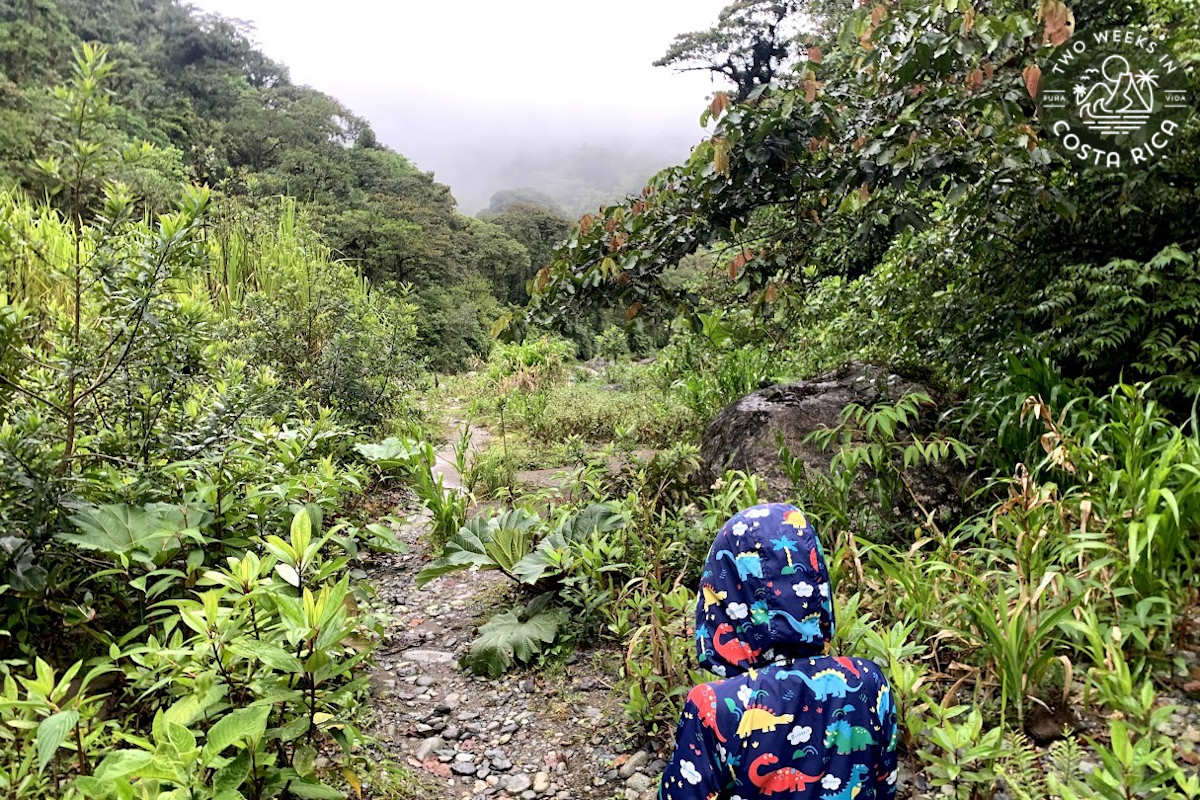
Costa Rica Weather Charts
To really visualize Costa Rica’s rainfall patterns, we’ve made some charts with data from different regions across Costa Rica. The data is based on 30-year averages from the National Meteorological Institute.
Our first chart shows the number of days with measurable rain each month at the five main weather stations.
Average Number of Rainy Days per Month
Data based on 30 year averages*
What Does the Chart Mean?
The main takeaway from this chart is that for 4-5 months per year, many locations in Costa Rica have barely any measurable rain (less than 7 days).
Usually this dry time spans from December to April (dry season, as mentioned above) and is most pronounced along the Pacific side of the country and Central Valley near San Jose.
The absolute driest area is Liberia in northwestern Costa Rica (Guanacaste) – see the orange line. On average, Liberia has less than 2 days with measurable rain, for 5 full months!
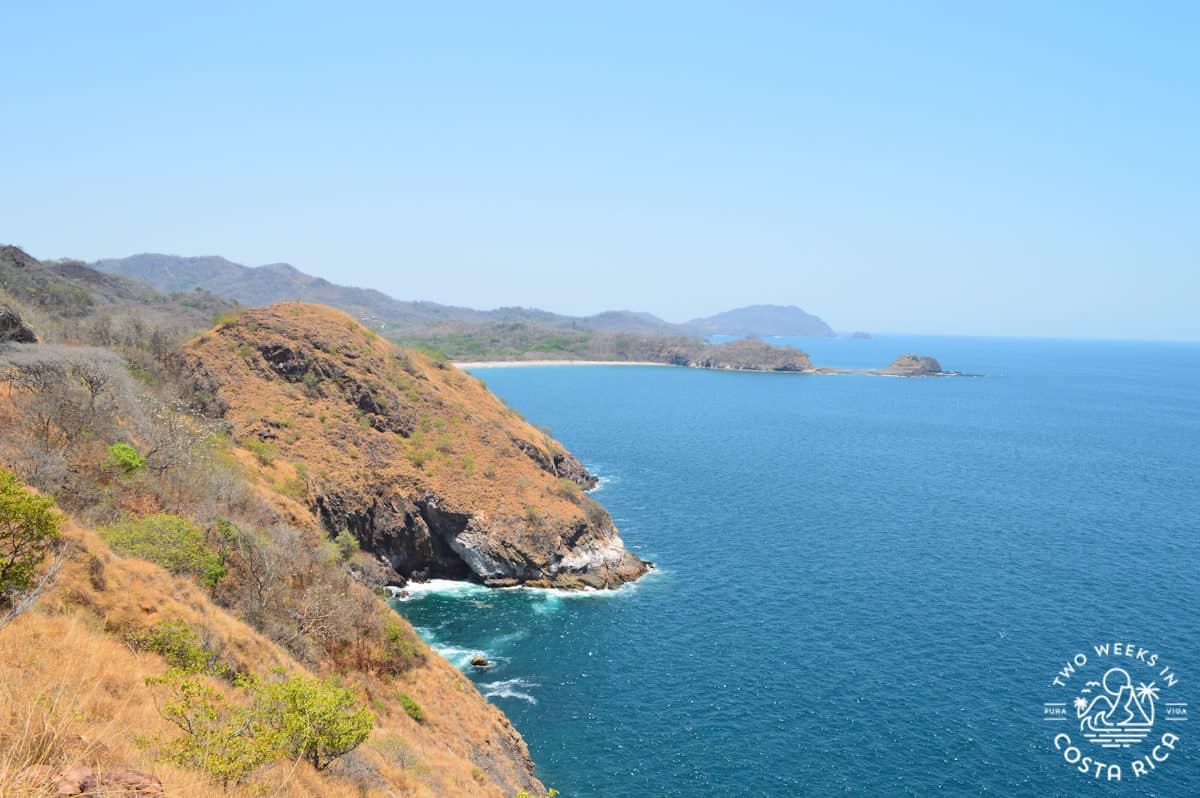
The wettest regions are the Caribbean (yellow line), which has sort of consistent rain all year long, and the Osa (south Pacific coast), which isn’t pictured because the data wasn’t available.
The Osa would follow a similar line as Quepos (central Pacific) but with higher values, since it is rainier the farther south you go on the Pacific coast. We’ll talk more about the Osa below.
Around May, you can see most of the lines curve dramatically upward. This shows the start of Costa Rica’s rainy season.
How Much Rain?
So we’ve established that you can visit Costa Rica for several months and not expect much rain. But what if your visit coincides with the rainy season? How much rain can you expect?
We get this question all the time! People want to know if their whole day or week will be a washout.
The truth is that when it rains in Costa Rica, it can come down very hard but it usually doesn’t last for too long.
A typical day in the rainy season starts off beautiful and sunny, with clouds starting to build around mid-day. Then there is a good chance of heavy rain or thunderstorms in the late afternoon or evening.
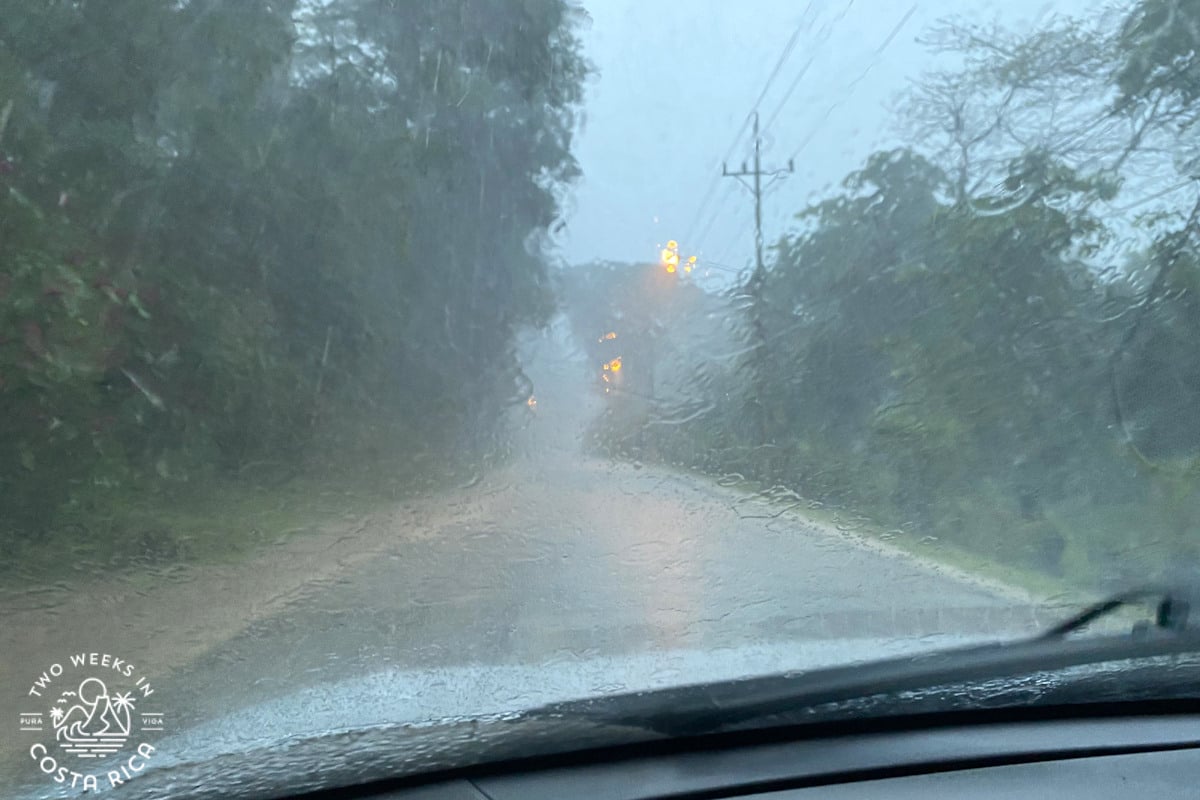
A storm might last only an hour or two, but it could dump a couple of inches in that time. Other times it can be cloudy and trying to rain all day but never really amount to a storm.
Here’s another chart with more detail on what you can expect for rainfall totals each month.
Average Monthly Rainfall in Costa Rica
Data based on 30 year averages*
*Osa data is unofficial weather station data (9 year trend)
What Does the Chart Mean?
Similar to previous chart, this one shows December to April seeing much less rain (except for the Caribbean in yellow).
The rain then really picks up in May, drops slightly in July, and intensifies again in September and October. November into early December is another transition time, where things start to dry out again.
For this chart, we’ve added some unofficial data from the wettest region of the country, the Osa (southern Pacific – from Dominical/Uvita to the Osa Peninsula). We don’t have any official data for that area so used a weather station at Reserva Playa Tortuga, south of Uvita.
The Osa gets the most rain by far, with annual averages around 237 inches (over 6,000 mm). That’s about 20 feet (6 meters) of rain per year! This is nearly 4 times the annual rainfall of Guanacaste, and more than doubles the average for the Central Valley and Central Pacific.
Although the Osa has substantially more rain than any other part of Costa Rica, that’s what makes it such a lush and biodiverse spot.
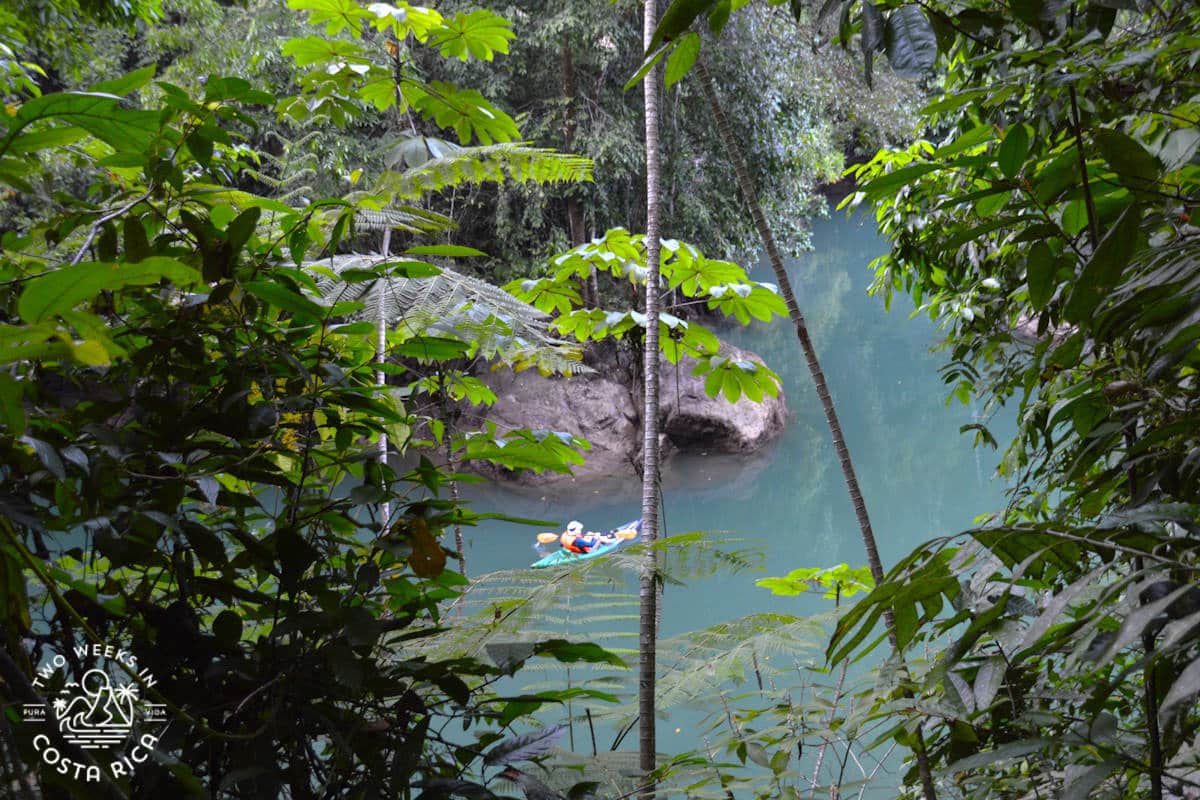
Keep in mind too that rain often comes all at once in a short burst of time. Even in places like the Osa, there’s usually plenty of sunny days to enjoy. Rain usually occurs in the afternoon or evening after the heat has built up during the day.
One month that you may want to avoid because of rain on the southern Pacific coast is October. Parts of Corcovado National Park are even closed that time of year.
Here’s one last chart that shows a comparison between the seasons.
Rainy Season vs. Dry Season Rainfall by Region
Data based on 30 year averages*
*Osa data is unofficial weather station data (9 year trend)
What Does This Chart Tell Us?
This one shows the average monthly rainfall for the dry season versus green season. You can really see the extreme difference in precipitation between the two seasons.
San Jose, Liberia, and Puntarenas get less than 1 inch (25 mm) of rain per month during the dry season compared to 9 or 10 inches (228-254 mm) during the green season.
Quepos and the Osa have even bigger differences, while the Caribbean (Limon) shows almost consistent average amounts per month throughout both seasons.
Costa Rica’s Temperatures
While rainfall can vary dramatically across Costa Rica, temperatures are a bit more predictable.
Coastal Area Temps
Both the Pacific and Caribbean coasts are hot all year long. Highs during the day can be around 85-95°F (29-35°C). The rainy season can be slightly cooler because of clouds and rain.
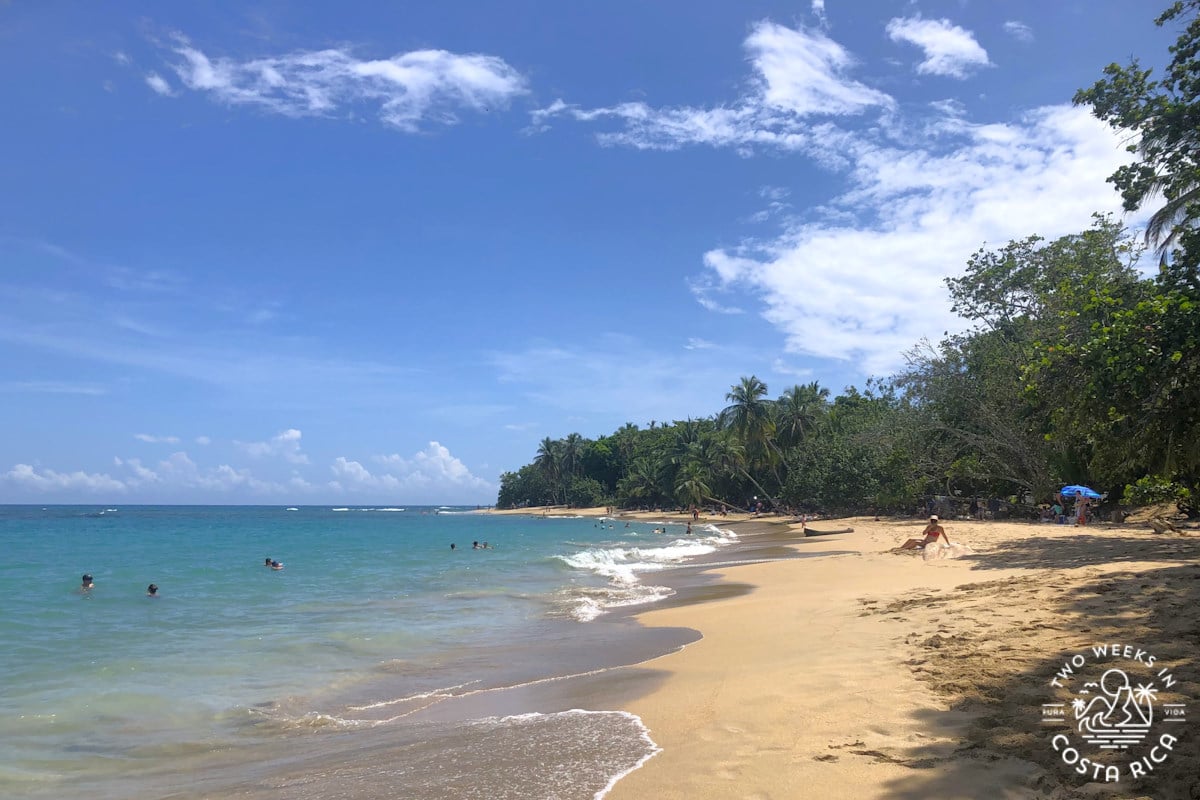
Guanacaste in Costa Rica’s northwest is the hottest region, with temperatures at or over 95°F (35°C) during the dry season (especially March and April).
Humidity levels along both coasts are generally high, between 60-90%, depending on the season and location. Guanacaste is a little less humid compared to other areas.
Luckily at the coast, you often have a nice sea breeze to make things a lot more comfortable!
Mid-Elevation & Central Valley Temps
Towns like Atenas and Grecia have what many people consider perfect temperatures. Mid 70s to mid 80s during the day and mid 60s to 70 overnight. These towns are popular with retirees because of that spring-like weather.
San Jose and the Central Valley also have mild temperatures year-round, though a little cooler. It can be around 70-80°F (21-27°C) during the day and cool off to a fresh 60-65°F (15-18°C) overnight. We always get cold in San Jose because we are used to the beach. Make sure to bring some warmer clothes. Check out our Packing List for more information.
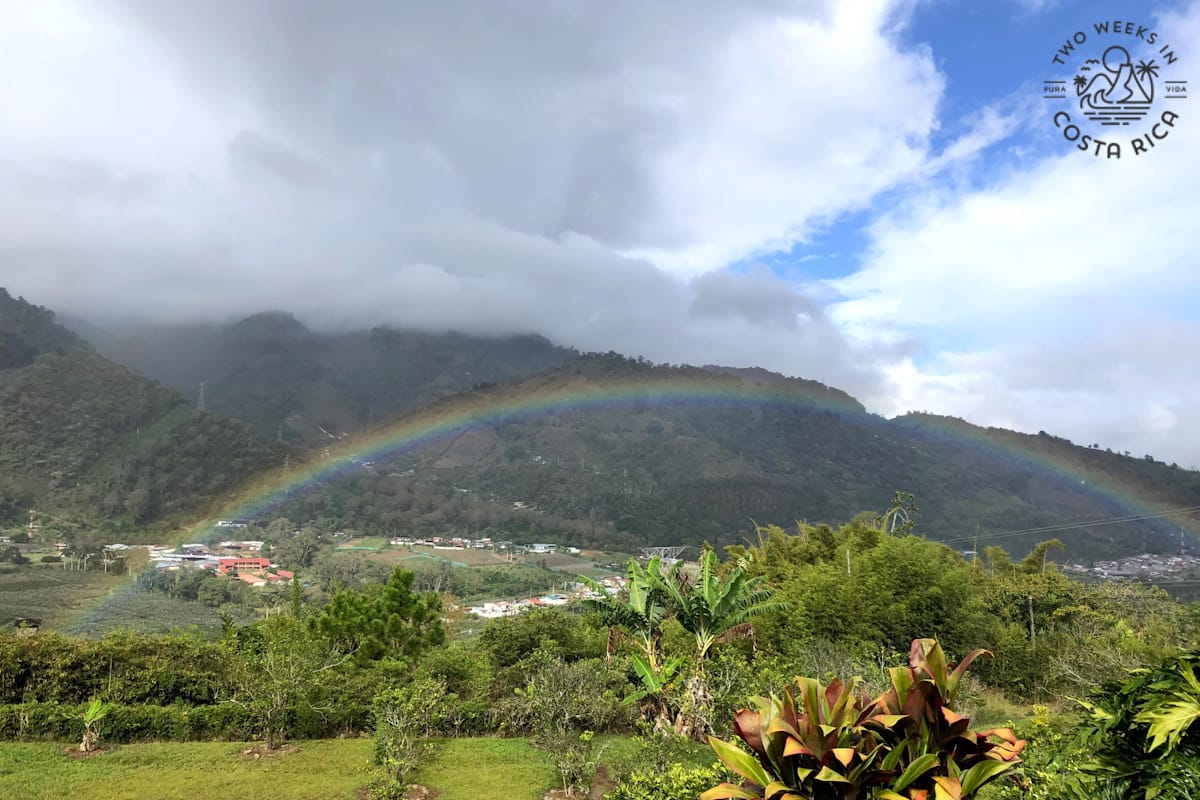
Cloud Forest Temperatures
The popular Monteverde Cloud Forest has similar temperatures to the Central Valley but as you get higher in elevation, it gets a lot cooler!
Accommodations in places like San Gerardo de Dota or the small towns around Poas Volcano often have heaters or fireplaces in the rooms.
Daytime temps can be between 60-70°F (15-21°C), but at night it can drop down to 50°F (10°C) or lower.
Microclimates
All the above information tells us the general trends but that is only part of the story. Costa Rica has dozens, if not hundreds, of microclimates.
These are areas that have their own weather patterns, maybe because of the location on a mountain or in a valley, proximity to the ocean, or other factors.
While it might be raining in one spot, 15 minutes away, it could be completely dry.
This happens constantly to us. We’ll be getting drenched at home with rain coming over the mountain, while just 20 minutes away, our friends near the beach are enjoying the sunset or vice-versa. If you are used to scattered showers where you live, it’s the same idea.
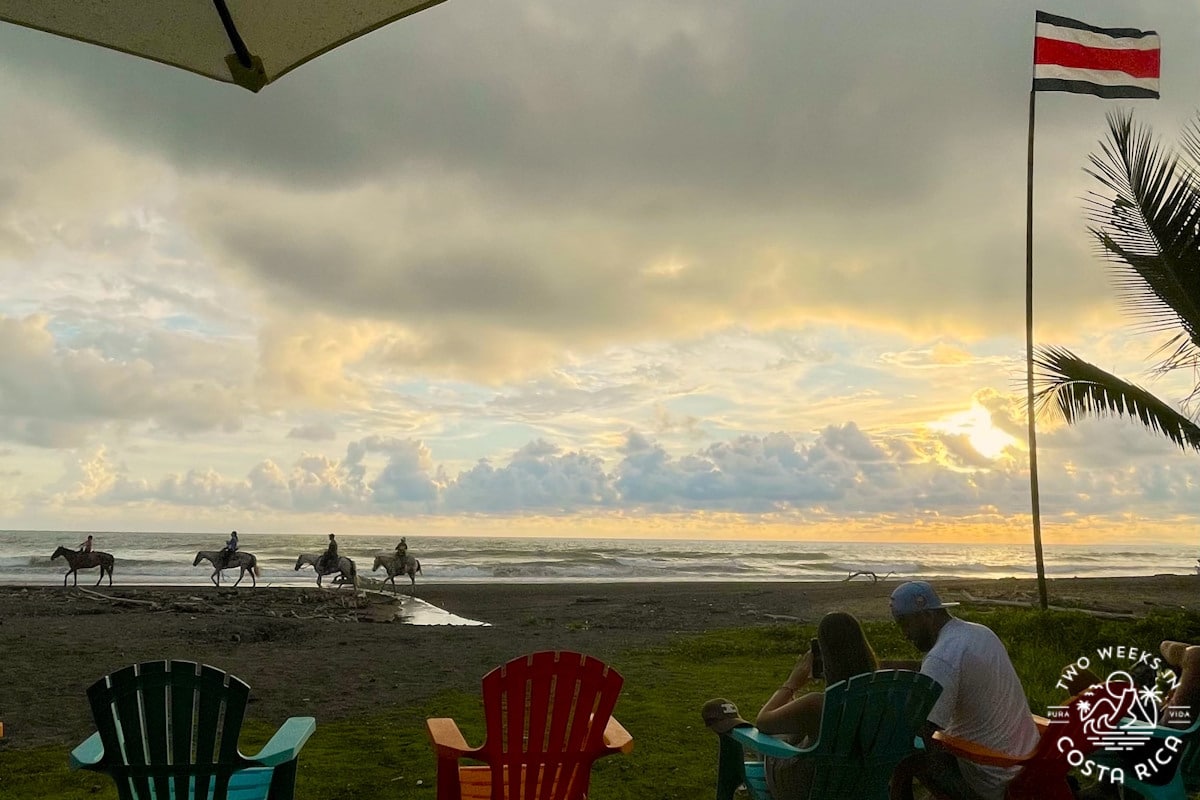
Costa Rica Rainy Season Travel Tips
If you’re traveling during Costa Rica’s rainy season, especially the hedge months of May to August, know that in our opinion, this is one of the best times of year to visit. The landscape is nice and green, there are fewer crowds, and you can get better deals. Our post, Why You Should Visit Costa Rica in the Rainy Season, has even more reasons why we love it.
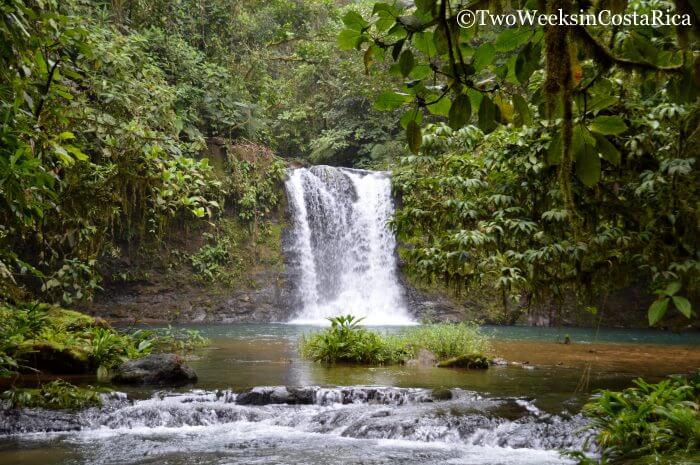
Below are a some rainy season travel tips to ensure you have a fantastic trip:
- Be road ready! Set off early, watch for road hazards, and take your time. Also have the right vehicle (an SUV is best for rainy season for the clearance). Read our rainy season driving post for more.
- Rise and shine! Book tours like nature hikes and adventure activities for the morning when it is less likely to rain.
- Avoid tight schedules. Most activities continue in the rain but might be a little delayed. Leave a buffer, just in case.
- Pack for it. Be prepared for the rain and you’ll enjoy yourself a lot more. There are certain things you’ll want like good footwear (along with an extra dry pair), a raincoat, dry bags, and more. Read our packing tips for a complete list.
Weather Resources
- Costa Rica’s Meteorological Institute – The government’s weather department for technical information (in Spanish).
- Costa Rica Weather – A website in English with the short term forecast and some helpful weather articles.
Conclusion
We hope that this post has helped you understand Costa Rica’s seemingly erratic weather and why your weather app is of no use. While complicated, Costa Rica’s weather patterns are what shape the beautiful landscapes that we all enjoy.
Frequently Asked Costa Rica Weather Questions
Probably not! Even during the rainy season, it usually only rains for a few hours a day, mostly in the afternoon or evening. Mornings are generally sunny and perfect for activities. Bigger weather events (passing tropical storms) could alter the pattern but it probably still won’t rain your entire vacation. One month that can be quite rainy is October (Pacific coast) so avoid this if you can.
Since long-term forecasts aren’t very reliable, it’s better to focus on the overall trends we discussed in this article. For real-time weather, sites like Accuweather are good (for current radar). A local resource is CostaRicaWeather.net, which has short-term forecasts and weather information.
Most tour companies in Costa Rica continue to operate during light or even moderate rain. We’ve done quite a few tours in the rain and still had a great time. It’s usually not a cold rain and sometimes you get wet anyway, like with rafting or surfing. For wildlife tours, the rain can even make the animals more active. If there is lightning, high winds, or really heavy downpours, the tour operator will likely try to wait it out, reschedule, or ultimately cancel. We have been booking tours in Costa Rica for many years, though, and can tell you that cancellations for weather don’t happen often.
It’s not uncommon to have some localized flooding during the rainy season. This happens mostly during peak rainy season (mid-September through early November). Sometimes it’s as simple as a low area of town getting inundated with deep puddles. Other times, streams or rivers can swell up and go over their banks. The good thing is that Costa Rica’s tropical soils handle it well and flooded areas usually return to normal within hours (days in more serious cases).
It’s okay to drive in the rain as long as you’re careful and take it slow. If the rain gets too heavy, you can always pull over and wait 10 minutes, sometimes it will just pass. We don’t recommend driving long distances at night, especially if it is raining. If you’re visiting during rainy season, an SUV is best for the higher clearance. For more tips, see our Driving in Costa Rica and Rainy Season Driving posts.
It’s important to be ready for a variety of weather conditions in Costa Rica. Have lightweight and quick-dry clothing, a raincoat, and closed-toed shoes with good grips for hiking, and of course flip-flops for the casual stuff. We have a very detailed packing list that can help.
Probably not. A good pair of closed-toed hiking shoes or boots are probably all you need. People often like Keens for waterfall hikes or watersports (rafting, rappelling, etc). Many reserves and tourist attractions have paths that are well maintained with gravel or paved surfaces. If you are going off-the-beaten path, you may want something more rugged.
Very rarely. A handful of hurricanes have hit Costa Rica but normally they curve past us to the north. The country sits south of most hurricane paths. That said, the outer rain bands from tropical storms/hurricanes can reach Costa Rica and affect the weather.
All of Costa Rica’s beaches have hot and humid weather. If you want cooler conditions, you could skip the beach and visit higher elevation destinations like San Jose, Monteverde, or San Gerardo de Dota. Atenas is another cooler spot that is only about 1 hour from the beach.
Have a question about the weather in Costa Rica? Ask us below.
Want to learn more to get ready for your trip? Check out these posts:
- Best Time to Visit Costa Rica: Learn more about what to expect during Costa Rica’s wet and dry seasons. Also tips on visiting during busy times of the year.
- Packing for Costa Rica: The Essentials – Detailed guide for just what to bring, including rainy season travel and destination-specific considerations.
- Driving in Costa Rica: A must-read if you’re renting a car. Learn about traffic laws and customs and how to stay safe behind the wheel.
- Money Matters: Everything you need to know about money in Costa Rica. Includes exchanging currency, tipping, and more.



